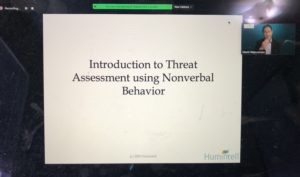 Thanks to everyone who attended our Introduction to Threat Assessment webinar!
Thanks to everyone who attended our Introduction to Threat Assessment webinar!
The session was held Tuesday, October 20th.
There were over 50 attendees from around the world, including many first responders.
We thank you for your service!
Dr. Matsumoto covered a variety of topics
He started with an overview of Humintell, who we are and what we do. Dr. Matsumoto explained the goals of the course and then an outline starting with an overview of threat assessment and nonverbal behavior. He reviewed three characteristics of all threats: motive, deception and reaction to context. In addition, he explained Humintell’s unique approach to behavior signature discovery for each of these three characteristics.
There was a significant portion spent discussing motives and research that has been done on this topic. Dr. Matsumoto highlighted one study he conducted that showed anger, contempt and disgust fuel hostility. The study was the first to show evidence of the connection between “ANCODI” emotions and aggressive behavior toward opponent groups.
From there, Dr. Matsumoto then moved on to explain different types of aggression and the importance of understanding and gaining a baseline. He explained there are different types of baselines including those in that are environmental (setting, flow of traffic, etc) and individual (which includes nonverbal expressivity and verbal expressivity). He stressed the importance of observing and identifying baselines around you and not ignoring anomalies.
Finally Dr. Matsumoto concluded by going over some behavioral signatures of imminent attack and introduced our Dangerous Demeanor Detector training. D3 is a training tool that will help you identify individuals who are on the verge of dangerous actions. It is based on years of research conducted by Humintell, LLC, involving not only the general public but also law enforcement officers in different countries who have witnessed and/or been a victim of a physical assault, and remembered the face of the assailant immediately prior to the attack.
is a training tool that will help you identify individuals who are on the verge of dangerous actions. It is based on years of research conducted by Humintell, LLC, involving not only the general public but also law enforcement officers in different countries who have witnessed and/or been a victim of a physical assault, and remembered the face of the assailant immediately prior to the attack.
Because we have been able to isolate exactly which faces are associated with an impending attack, we can teach you to identify them. The purpose is to alert you of the need to be more on guard, and perhaps take protective action. D3 trains you to be alert to both of these very different facial expressions. Learn more about Dangerous Demeanor here.
trains you to be alert to both of these very different facial expressions. Learn more about Dangerous Demeanor here.
The session ended with a 15 minute live Q&A with attendees.
Missed this session? Don’t worry! You can purchase the recording.
The post Threat Assessment Webinar Recap first appeared on Humintell.
 Will you be tuning in to watch the Vice Presidential Debates tonight? A warning: don’t trust every media analyst you see or read who invokes body language.
Will you be tuning in to watch the Vice Presidential Debates tonight? A warning: don’t trust every media analyst you see or read who invokes body language. The COVID-19 global pandemic has undoubtedly changed people’s lives. Virtual meetings have largely replaced in-person interactions leading to what some call
The COVID-19 global pandemic has undoubtedly changed people’s lives. Virtual meetings have largely replaced in-person interactions leading to what some call